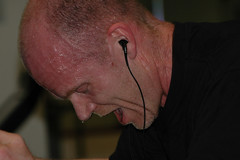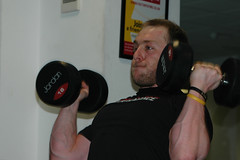The April and May strength challenges focused on relative strength (ie strength relative to bodyweight). If you struggled with these challenges, or struggle in general to do bodyweight movements such as pull ups and dips, then here are a few methods you can use in your training to get stronger.
Improve your absolute strength – The greater the maximal amount of weight you can lift the greater your relative strength will be. For example, if Person A who weighs 80kg can deadlift a maximum of 80kg and Person B, who is also 80kg, can deadlift a maximum of 160kg (double bodyweight) think how comfortable lifting 80kg will be to Person B. Drop your reps (3-5 rep range) and focus on lifting heavier weights with solid technique. You wont improve your absolute strength if you are not lifting heavier loads. Focus on the big compound movements which use the most muscle – squats, deadlifts, bench press – and allow you to use the most load.
Do more (concentric) reps. Yea, it sounds simple, just do more pull ups and dips. But how?
Use Accommodating sets – To crank out a few more reps you can switch to an easier version of the exercise as you fatigue. For pull ups, you can switch from an overhand wider grip to a reverse narrower grip then switch to an inverted row. With the inverted row you can start with a low bar and increase the height of the bar to make the exercise easier. For dips, you can switch to decline press ups (feet elevated) to normal press ups then incline press ups (against a bench or bar – same set up as inverted row).
Use Pyramid structured reps (with a short rest pause) – Say the most pull ups (or dips) you can do in 1 set is 4 reps. You are going to perform 3 reps, short rest, perform 2 reps, short rest, then perform 1 rep. That would be 1 set for a total of 6 reps. With the rest period, you want to reduce it as the reps decrease. In this example I would suggest 20 seconds after the first set of 3, then 10 seconds after the set of 2. The goal is to gradually reduce the rest until there is none. You will be surprise how fast this helps build strength and in no time you will be cranking out more reps.
Use Forced reps – You will need a training partner or gym buddy for this one. As you fatigue and get close to failure (on pull ups or dips) your training partner can assist you by supporting some of your bodyweight (making the exercise easier as you now have less load to move) and by helping you through the full range of motion by lifting/pushing you through your sticking points.
Increase your Isometric and Eccentric strength – Your isometric or static strength can be increased by holding a position for time. For pull ups, try holding yourself at the top of each rep for 2-3 seconds before lowering to the start position. Or you could try holding the top position for as long as possible, trying to beat your best time each rep. The static hold does not have to be at the top of the rep, you can hold yourself at any point (such as the middle point of the rep) and gain isometric strength. This works better for dips as holding your self at the top or bottom of the dip position is no where near as challenging as holding your bodyweight in the middle point of the rep. The same can be used to improve your press ups. Try holding yourself at the bottom position of a press up (with only your hands & toes on the ground, keep your legs, stomach & chest off the floor!)
Your eccentric strength can be improved through negative reps. The eccentric phase of any movement is around 40% stronger than the concentric phase, so by improving your eccentric strength your concentric strength will also get stronger. For pull ups, lower yourself from the top position, as controlled as you can, so it takes around 5 seconds to return to the start position. For dips, the eccentric phase is lowering from the start position to the bottom point of the dip – again keep it controlled and lower for around 5 seconds. Negative reps can also be used with your weight lifting exercises to improve your absolute strength. For example, on the bench press, the eccentric phase is from the top position down to the chest. Make sure you have a spotter or training partner if you plan on implementing negative reps into your weightlifting program.
Now get out there, and do more pull ups!






